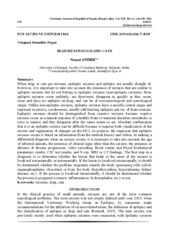Приказ основних података о документу
Seizures in dogs and cats
| dc.creator | Andrić, Nenad | |
| dc.date.accessioned | 2023-12-20T07:56:08Z | |
| dc.date.available | 2023-12-20T07:56:08Z | |
| dc.date.issued | 2021 | |
| dc.identifier.issn | 1840-2887 | |
| dc.identifier.uri | https://vet-erinar.vet.bg.ac.rs/handle/123456789/3443 | |
| dc.description.abstract | When dogs or cats get seizures, epileptic seizures and epilepsy are usually thought of. However, it is important to take into account the existence of seizures that are similar to epileptic seizures but do not belong to epileptic seizures (non-epileptic seizures). Nonepileptic seizures occur suddenly, are short-term, disappear as quickly as they occur, recur and have no epileptic etiology and can be of non-neurological and neurological origin. Unlike non-epileptic seizures, epileptic seizures have a specific neural origin and represent excessive, synchronous, usually self-limiting epileptic activity of brain neurons. Epileptic seizures should be distinguished from reactive seizures because reactive seizures occur as a natural response of a healthy brain to transient disorders (metabolic or toxic in nature) and they disappear after the cause ceases to act. Absolute confirmation that it is an epileptic seizure can be difficult because it requires both visualization of the seizure and registration of changes on the EEG. In practice, the suspicion that epileptic seizures occurs is based on information from the medical history and videos. In making a differential diagnosis when an seizure occurs, it is necessary to take into account the age of infected animals, the presence of clinical signs other than the seizure, the presence or absence of disease progression, video recording, blood counts and blood biochemical parameters results, CST test results, and X-ray, MRI or CT findings. The first step in a diagnosis is to determine whether the lesion that leads to the onset of the seizure is localized extracranially or intracranially. If the lesion is localized extracranially, it should be determined whether the problem originates outside the body (poisoning with xylitol, organophosphates, chocolate) or from the body (hypothyroidism, hypocalcemia, kidney disease, etc.). If the process is localized intracranially, it should be determined whether the process is progressive (tumor, inflammation, hydrocephalus, etc.) or not. | sr |
| dc.language.iso | en | sr |
| dc.publisher | Banja Luka : PI Veterinary institute of Republic of Srpska 'Dr Vaso Butozan' | sr |
| dc.rights | openAccess | sr |
| dc.rights.uri | https://creativecommons.org/licenses/by/4.0/ | |
| dc.source | Veterinary Journal of Republic of Srpska | sr |
| dc.subject | seizures | sr |
| dc.subject | dogs | sr |
| dc.subject | cats | sr |
| dc.title | Seizures in dogs and cats | sr |
| dc.type | article | sr |
| dc.rights.license | BY | sr |
| dc.citation.volume | 21 | |
| dc.citation.issue | 1-2 | |
| dc.citation.spage | 146 | |
| dc.citation.epage | 153 | |
| dc.identifier.doi | 10.7251/VETJEN2101146A | |
| dc.identifier.fulltext | http://veterinar.vet.bg.ac.rs/bitstream/id/10317/bitstream_10317.pdf | |
| dc.type.version | publishedVersion | sr |

